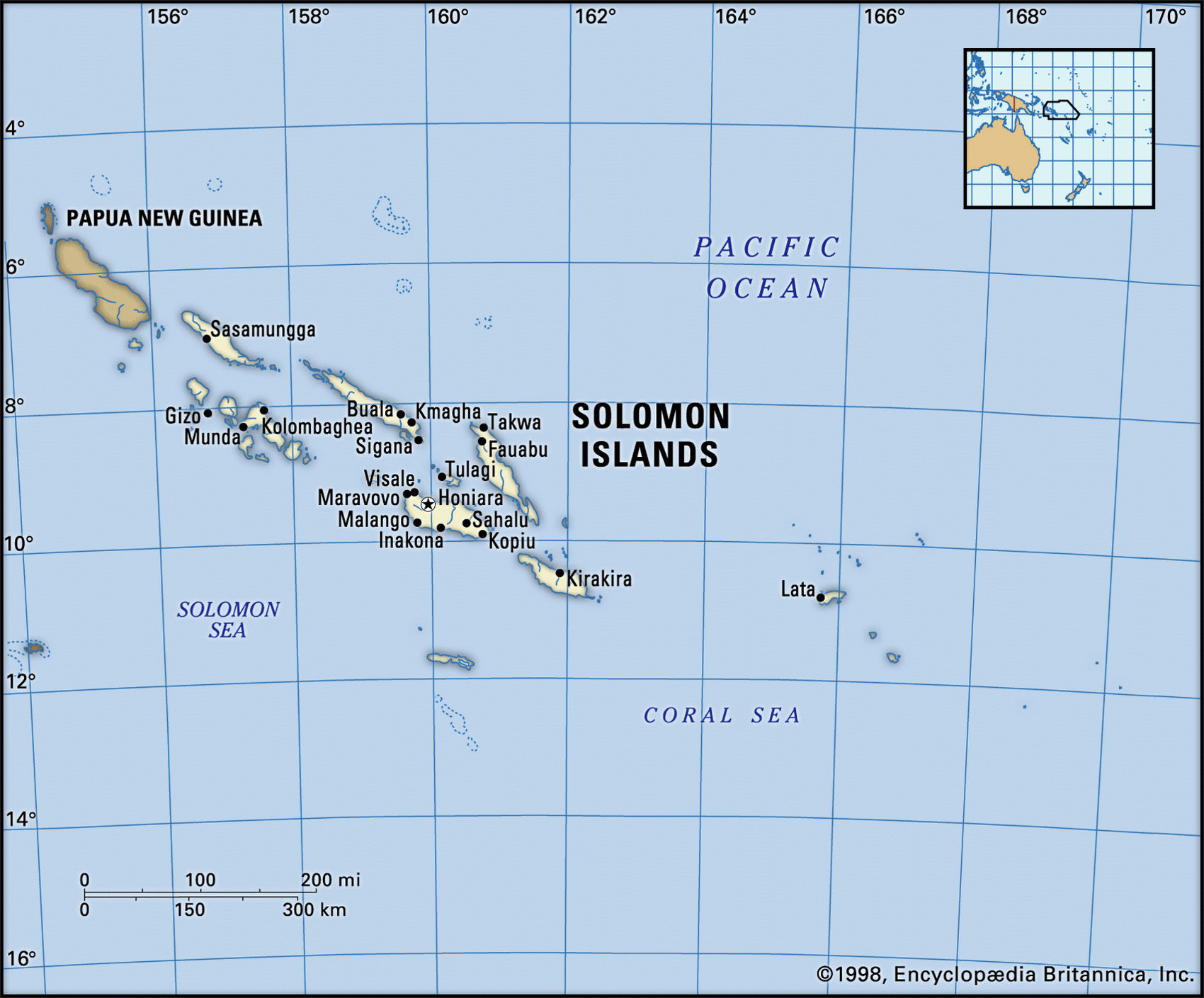Map of Solomon Islands and geographical facts
Where Solomon Islands on the world map. Map of Solomon Islands
Map of Solomon Islands with cities. Where Solomon Islands is on the world map. The main geographical facts about Solomon Islands - population, country area, capital, official language, religions, industry and culture.

Fact File Solomon Islands
Official name Solomon Islands
Form of government Constitutional monarchy with single legislative body (National Parliament) '
Capital Honiara
Area 28,450 sq km (10,985 sq miles)
Time zone GMT + 11 hours
Population 495,000
Projected population 2015 719,000
Population density 17,4 per sq km (45.1 per sq mile)
Life expectancy 72.4
Infant mortality (per 1,000) 22.1
Official language English
Other languages Pidgin, approximately 80 different indigenous languages
Literacy rate 62 %
Religions Protestant 77% (including Anglican 34%, Baptist 17%, United 11 %, Seventh-Day Adventist 10%), Roman Catholic 19%, indigenous beliefs 4%
Ethnic groups Melanesian 93%, Polynesian 4%, Micronesian 1.5%, European 0.8%, other 0.7%
Currency Soloman Islands dollar
Economy Agriculture 85%, services 10%, industry 5%
GNP per capita US$ 1,700
Climate Tropical, most rain falling November to April
Highest point Mt Makarakomburu 2,447 m (8,126 ft)
Map reference Pages 140, 141
Solomon Islands
The Solomon Islands lie in the western Pacific, northeast of Australia. Inhabited by Melane-sian people since about 1000 вс, they consist of two chains of islands running southeast of Bougainville. They were named by the Spanish navigator Alvaro de Mendana, who visited them in 1568 and thought he had found "the riches of Solomon." Twenty years later he returned and established a small, short-lived colony on the Santa Cruz Islands. Outside contacts were few in the ensuing centuries. In the 1870s and 1880s labor recruiters called "blackbirders" were busy inveigling islanders into working on Australian sugar plantations and their unsavory activities led Britain to establish a protectorate over the Southern Solomons in 1893.
In the Second World War the Solomons were occupied by the Japanese. The battle for Guadalcanal saw fierce fighting between Japanese and US forces, the islands overall being the scene of several major Allied naval and military victories. In recent years relations with Papua New Guinea have been strained because of the Solomon Islands' support for secessionists on Bougainville and the rebels of the Bougainville Revolutionary Army. Although Bougainville is geographically and ethnically a part of the Solomon Islands group, it has been treated politically as a part of Papua New Guinea for more than one hundred years.
Geologically, the islands represent a part of the submerged outermost crustal fold of the ancient Australian continent. Their interiors are rugged and mountainous. The six main islands— Guadalcanal, Malaita, New Georgia, Makira (formerly San Cristobal), Santa Isabel, and Choiseul— are all of volcanic origin, and have densely forested ranges with steep-sided river valleys. Around the coasts are narrow plains where most of the population live as subsistence farmers growing beans, coconuts, palm kernels, rice, potatoes, and vegetables. Palm oil, cocoa and copra are leading agricultural exports, and tuna fish is the single biggest earner. Forestry is an important industry but the unsustainable level of timber extraction is an environmental concern. The islands are rich in undeveloped mineral resources such as lead, zinc, nickel, gold, bauxite, and phosphate—significant phosphate deposits are being mined on Bellona Island. The government is nearly insolvent and depends on foreign aid; another problem is the high population growth rate.